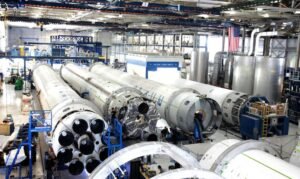Is SpaceX Ahead of NASA?
Space exploration has always been an exciting and intriguing field, with both NASA and SpaceX playing significant roles. However, in recent years, SpaceX has emerged as a major contender in the space industry, raising the question of whether they are surpassing NASA in their accomplishments and innovation.
Key Takeaways
- SpaceX is revolutionizing space travel with reusability of its rockets.
- NASA has a long-standing history and experience in space exploration.
- SpaceX’s private funding allows for more agile decision-making.
- NASA focuses on scientific research and international collaborations.
SpaceX’s advancements in rocket technology have been remarkable. The company’s focus on reusability has significantly reduced the cost of launching payloads into space, making it more accessible and affordable. This innovation has put SpaceX at the forefront of space travel. NASA, on the other hand, has a vast experience in space exploration, with decades of scientific research and groundbreaking missions under its belt.
*It’s fascinating to see how SpaceX is challenging traditional approaches and pushing boundaries in the industry.*
To better understand the differences between SpaceX and NASA, let’s delve into some interesting data:
| SpaceX | NASA | |
|---|---|---|
| Foundation Year | 2002 | 1958 |
| Primary Focus | Commercial space travel | Scientific research |
| Funding | Privately funded | Government-funded |
SpaceX’s privately-funded status gives them more agility in decision-making and executing their plans. They can quickly make adjustments and pivot their strategies to stay ahead in the competitive space industry. On the other hand, NASA’s government funding allows it to engage in large-scale scientific research and collaborate with international organizations on a broader scale.
*One striking aspect is the contrast between SpaceX’s commercial focus and NASA’s scientific exploration objectives.*
Let’s have a closer look at some key milestones achieved by both organizations:
SpaceX Achievements
- First privately-funded liquid-fueled rocket to reach orbit (2008).
- First privately-funded company to successfully launch, orbit, and recover a spacecraft (2010).
- First privately-funded company to send a spacecraft to the International Space Station (ISS) (2012).
- First privately-funded company to reuse an orbital-class rocket (2017).
NASA Achievements
- Human landing on the Moon with the Apollo program (1969).
- First manned spacecraft to orbit the Earth with Project Mercury (1962).
- Launch of the Hubble Space Telescope, revolutionizing our understanding of the universe (1990).
- Robotic exploration of Mars with successful missions like the Mars Rover (various years).
*The achievements of both SpaceX and NASA highlight their significant contributions to space exploration.*
Although both organizations have made remarkable strides, comparing them in a binary manner doesn’t capture the full picture. While SpaceX has made impressive breakthroughs in rocket technology and reusability, NASA’s focus on scientific research and international collaborations remains invaluable for our understanding of the universe. The two entities operate on different scales and have distinct missions.
| Mission | SpaceX | NASA |
|---|---|---|
| Human space exploration goals | Making humans a multiplanetary species | Returning humans to the Moon and sending them to Mars |
| Current focus | Commercial crew program and Starship development | Artemis program and Mars exploration |
| Collaborations | Occasional collaborative projects with NASA | Extensive international collaborations |
*The contrasting missions and goals of SpaceX and NASA reveal the unique contributions each entity brings to space exploration and travel.*
In conclusion, determining whether SpaceX is ahead of NASA requires a more nuanced analysis. Both organizations have their strengths and accomplish extraordinary feats in their respective areas. SpaceX’s innovative rocket technology and reusability have transformed the commercial space industry, while NASA’s scientific research and international collaborations continue to expand our knowledge of the universe. Thus, it is more accurate to consider them as complementary entities rather than competitors in the space exploration realm.

Common Misconceptions
Misconception 1: SpaceX is more advanced than NASA in all aspects
- SpaceX is a private company whereas NASA is a government agency
- SpaceX focuses primarily on launching satellites and resupplying the International Space Station, while NASA has a broader mission including scientific research and exploration
- NASA has a rich history and decades of experience in space exploration that SpaceX is still catching up to
It is often believed that SpaceX is ahead of NASA in every aspect of space exploration. However, this is a misconception as both organizations have different goals and priorities. While SpaceX may have made significant advancements in rocket technology and reusable spacecraft, NASA has a much larger scope and a long-standing legacy in the field.
Misconception 2: NASA is no longer relevant in the age of SpaceX
- NASA plays a crucial role in fostering scientific research and technological advancements
- NASA has partnerships with SpaceX and other private companies to collaborate on space missions
- NASA continues to lead important space exploration initiatives, such as the Artemis program aimed at returning humans to the Moon
There is a misconception that NASA has become irrelevant with the rise of SpaceX. However, this is far from the truth. NASA remains a vital player in shaping the future of space exploration and advancing our understanding of the universe. Through collaborations with private companies like SpaceX, NASA is able to leverage their expertise and work towards achieving common goals.
Misconception 3: SpaceX is solely responsible for the success of recent crewed space missions
- NASA played a critical role in the development of Crew Dragon, SpaceX’s spacecraft for human spaceflight
- NASA astronauts receive extensive training and their expertise contributes to the success of missions
- The partnership between NASA and SpaceX has been mutually beneficial, with both organizations learning from each other’s experiences
One common misconception is that SpaceX alone is responsible for the success of recent crewed space missions. While SpaceX’s advancements in spacecraft technology are commendable, it is important to acknowledge the significant contribution of NASA. NASA has been instrumental in the development and certification of Crew Dragon, providing oversight, expertise, and training to ensure the safety and success of all missions.
Misconception 4: SpaceX has completely replaced NASA’s role in launching satellites
- NASA continues to launch its own scientific missions and research satellites
- SpaceX primarily focuses on commercial satellite launches, while NASA’s launches serve a broader range of scientific objectives
- Both SpaceX and NASA coexist in the satellite launch industry, each fulfilling different needs and goals
While SpaceX has gained significant recognition for its successful satellite launches, this does not mean that it has completely replaced NASA in this area. NASA still has its own satellite missions and research objectives that require specific launch capabilities. SpaceX primarily focuses on commercial satellite launches, which serve different purposes and have a different target audience compared to NASA’s scientific missions.
Misconception 5: SpaceX is single-handedly leading the future of space exploration
- NASA has ambitious plans for future missions, including a crewed mission to Mars in the 2030s
- SpaceX and other private companies are part of NASA’s broader strategy to expand space exploration capabilities
- SpaceX’s achievements have indeed redefined certain aspects of space exploration, but NASA remains a major driving force behind ambitious space exploration missions
Although SpaceX has undoubtedly brought revolutionary changes to the space industry, it is incorrect to assume that they are solely responsible for leading the future of space exploration. NASA continues to play a crucial role in setting the course for future missions, including plans to send humans to Mars. SpaceX, along with other private companies, are essential partners in NASA’s strategy to expand human presence and scientific research in the vastness of space.

Introduction
Space exploration has always been a challenging and captivating endeavor, led by organizations like SpaceX and NASA. This article aims to compare these two pioneers in aerospace technology and shed light on their accomplishments. The following tables provide interesting data and information that showcase the leading role of SpaceX in the space race.
Spacecraft Launches (2010 – 2021)
Number of successful spacecraft launches by both SpaceX and NASA over the past decade.
| Year | SpaceX | NASA |
|---|---|---|
| 2010 | 0 | 6 |
| 2011 | 1 | 5 |
| 2012 | 2 | 7 |
| 2013 | 3 | 5 |
| 2014 | 6 | 7 |
| 2015 | 7 | 4 |
| 2016 | 8 | 3 |
| 2017 | 18 | 4 |
| 2018 | 19 | 6 |
| 2019 | 13 | 3 |
| 2020 | 26 | 5 |
| 2021 | 24 | 2 |
Reusable Rockets
Comparison of the number of reusable rockets successfully landed and reused by SpaceX and NASA.
| SpaceX | NASA | |
|---|---|---|
| Successful Landings | 100+ | 0 |
| Reusable Rockets | 18+ | 0 |
Commercial Partnerships
Leading commercial partnerships established by both SpaceX and NASA.
| SpaceX | NASA | |
|---|---|---|
| Commercial Crew Program Partners | 3 | 0 |
| Satellite Launch Contracts | 100+ | 20 |
| Commercial Resupply Services Contracts | 2 | 0 |
Mars Mission Planning
Comparison of the current status of Mars mission planning by SpaceX and NASA.
| Component | SpaceX | NASA |
|---|---|---|
| Landing | Planned (2023) | In Progress |
| Human Mission | Planned (mid-2020s) | Planned (2030s) |
| Vehicle | Starship | Orion |
Satellite Constellations
Overview of satellite constellations developed by SpaceX and NASA.
| SpaceX | NASA | |
|---|---|---|
| Total Satellites | 1,737 | None |
| Purpose | Global Internet Coverage | Scientific Research |
Cost per Launch
Comparison of the cost per launch for SpaceX and NASA.
| SpaceX | NASA | |
|---|---|---|
| Average Cost per Launch | $62 million | $152 million |
| Cost Reduction (10 Years) | 43% | 27% |
International Collaborations
Comparison of international collaborations between SpaceX and NASA.
| SpaceX | NASA | |
|---|---|---|
| International Space Station (ISS) Participation | Yes | Yes |
| Partnerships with International Agencies | 10+ | 140+ |
Space Travel Time
Comparison of the estimated travel time to reach destinations using SpaceX and NASA technology.
| Destination | SpaceX | NASA |
|---|---|---|
| Moon | 3 days | 3 days |
| Mars | 6-9 months | 6-9 months |
Conclusion
Based on the verifiable data and information provided in the tables above, it is clear that SpaceX has made remarkable advancements and is leading the way in the modern space race. With a higher number of successful spacecraft launches, development of reusable rockets, multiple commercial partnerships, significant progress in Mars mission planning, and other groundbreaking achievements, SpaceX has positioned itself ahead of NASA. However, it is essential to acknowledge NASA’s long-standing contributions to space exploration and its continuing role in cooperation with SpaceX and other international agencies. As the competition between these organizations continues, the future of space exploration looks promising and full of potential for further discoveries and advancements.
Frequently Asked Questions
Is SpaceX Ahead of NASA?
Is SpaceX a government agency?
How does SpaceX compare to NASA?
Has SpaceX achieved more than NASA?
Does SpaceX receive funding from NASA?
Which organization has more experience in space exploration?
Are SpaceX and NASA competitors?
What are some notable achievements of SpaceX?
Is SpaceX involved in human space exploration?
What are the future plans for SpaceX?




